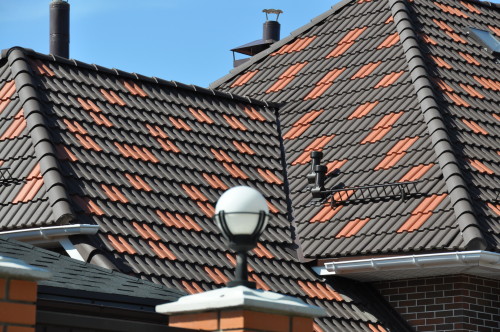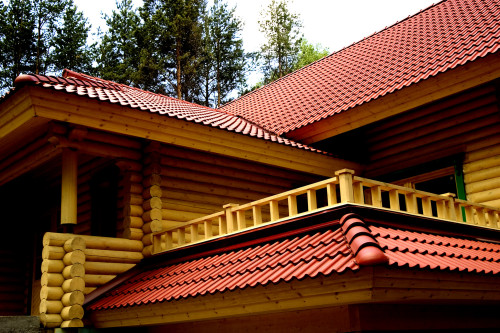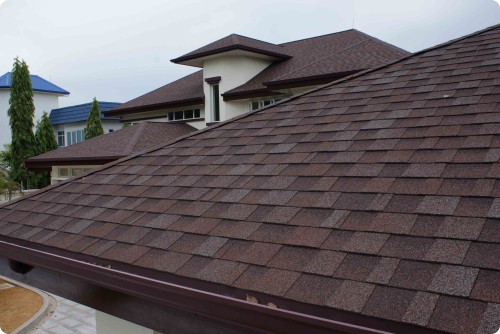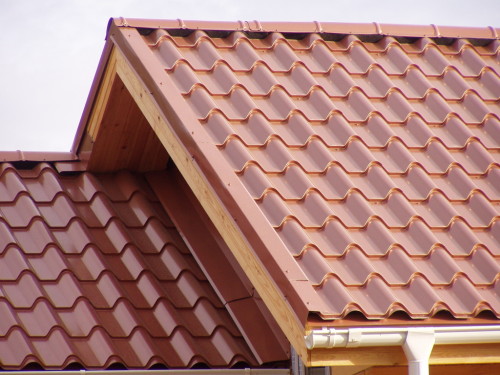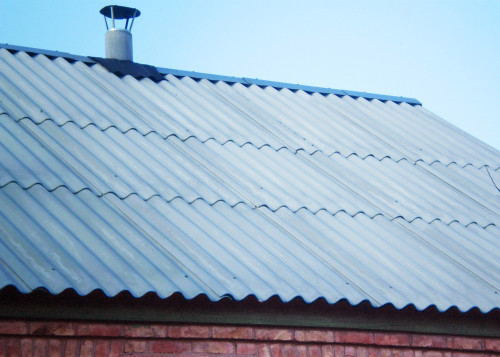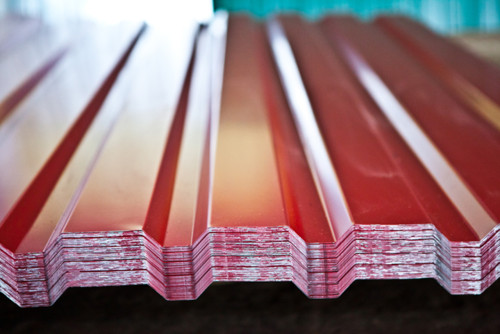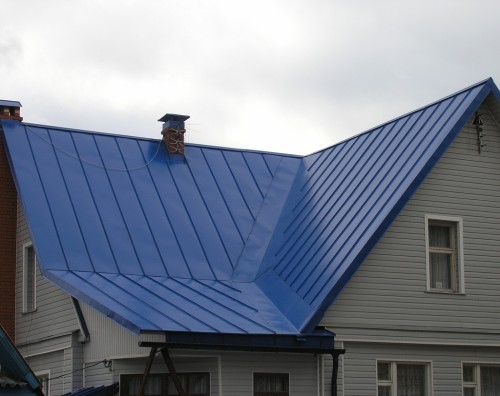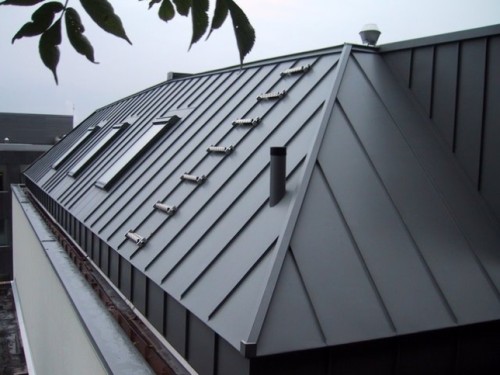Roofing material for the roof should be selected with particular thoroughness, given not only its decorative properties, but also operational characteristics. We will talk about the types, features and intricacies of choosing a coating in this article.
Content
How to choose roofing material
Before acquiring the material for the decoration of the roof, it is necessary to decide which one will suit you, and for this you should take into account the following factors:
- The load on the roof, which implies the weight of the roof pie, the estimated mass of the snow cover, the average wind loads in a particular region.
- Architectural design features. To carry out roofing on the roof and for the choice of suitable material, it is important to take into account the structural features of the structure, the configuration and the slope of the roof.
- The climatic and operational conditions on which the service life of the roof depends.
- The durability of the material and its fire resistance. For example, it makes no sense to purchase an expensive coating for a household building on the site, while for a residential building it is better to choose a roof that will last more than a dozen years.
All roofing coatings for the roof have a certain warranty period. It is worth noting that in some cases, if the material was laid in compliance with all the rules, the real service life can significantly exceed those declared by the manufacturer. We will deal with this in more detail:
- The guarantee for soft tiles is often from 15 to 20 years and applies to concepts such as tightness, integrity, lack of production defects. Warranty obligations do not apply to the conservation of the material of their initial color. The real life of soft tiles is many times higher than the warranty, and such a roof can last without repair from 30 to 50 years.
- Manufacturers of metal tiles give a guarantee of 5 to 15 years to their product. As in the above case, the coating over this time can change the shade, burn out, pollute, change the gloss. The real service life of the metal tile often ranges from 30 to 50 years.
- The warranty period of natural tiles is 20-30 years, which applies to the frost resistance of the material. Practice shows that natural tiles are very durable and can last even 100 and 150 years.
- The slate has a lower service duration, in reality it ranges from at 30-40 years, while warranty obligations are supported by the manufacturer for 10 years.
- Bitumen wavy sheets with proper styling and operation do not require repair for about 15-25 years. The warranty on them is 15 years and does not apply to the preservation of the material of its original shade.
- Roofing steel and profiled flooring have a warranty period equal to 15-20 years. Warranty obligations do not include risks associated with improper transportation or operation of the goods. In real life, corrugated board and steel can serve up to 50 years.
- Slantsy coatings are as durable as natural tiles. The warranty on them ranges in the interval of 30-40 years, while in fact such a roof can maintain its integrity for 150 or even 200 years.
- Falts roofs last about 50 years, their manufacturers give the buyer a guarantee for 15-20 years.
When choosing a material for decoration of the roof, it is important to pay attention to the following characteristics:
- The composition and environmental friendliness of the coating. It is important that the roof, especially in residential construction, is safe for a person and not allocate harmful substances into the environment.
- Texture, density, color of the material.
- The maximum and minimum roof slope suitable for a specific type of coating.
- The main methods and principles of installation of roofing material.
- Features of the roofing of the roof, that is, the presence and characteristics of layers included in the roofing pie.
- The scope of the use of certain roof coatings, the pros and cons of each of the materials.
- Prices for roofing materials for roofs.
Each of the coatings has its own sphere of use and is used in certain cases:
- Roll roofing materials are ideal for flat roofs. Work on their installation can be performed quickly enough.
- It is convenient to use leaf coatings where you need to treat large areas.
- Fine -piece roofs like tiles are durable, look stylish, expensive and prestigious. Most often they are used where it is necessary to achieve a beautiful effect and emphasize the status of the owner of the house.
- Incorrect materials are needed where it is important to create a seamless, durable, waterproof coating, while spending a minimum of time. Burning roofs do not look as attractive as, for example, tile, but they are much cheaper and serve for a very long time.
Types and features of roofing materials
Ceramic tiles
Ceramic tiles are carried out by forming and burning clay mass, the natural color of such a coating is usually red-brown. Separate tiles have dimensions 30x30 cm and weigh 2 kg each. If you decide to finish the roof with a tile, make sure that the structure of the structure is from 22 ° to 60 °. If the slope of your roof is coolest, it is necessary to provide additional mounts to cover. With a more gentle roof, it is important to create improved ventilation and waterproofing.
The advantages of porcelain include the following characteristics:
- simplicity of care and cleaning;
- good soundproofing properties;
- absolute non -combustibility, resistance to moisture, good frost resistance. Such a roof can withstand more than 1000 freezing and thawing cycles;
- rich color palette, as well as a variety of shapes;
- the porosity that provides good vapor permeability.
Of the shortcomings of the coating, you can call the following:
- a large mass, due to which you have to create an exceptionally strong rafter system;
- fragility of parts;
- the complexity of the use on the roofs of a complex configuration.
Cement-sand tiles
In appearance, cement-sand tiles are very reminiscent of ceramic, but due to a simpler manufacturing process it costs somewhat cheaper. The slope of the roof for the use of cement-sand tiles should be 20 ° -60 °.
Consider the advantages of such a coating:
- over time, the material not only does not become fragile, but, on the contrary, acquires greater firmness and density;
- such tiles perfectly tolerates the effects of any aggressive chemicals, as well as radiation;
- the frost resistance of the coating is another advantage. Like the previous type of roof, the cement-sand tile takes up to 1000 freezing cycles.
The material has some disadvantages:
- large weight and massiveness that weight the weight of the roof pie;
- the risk of damage during the transportation of the coating to the place of construction work.
Bitumen tile
Such tiles are made of bituminous tiles covered with several layers: fiberglass, cellulose, polyester, paint. Separate elements of such a material are perfectly joined with each other, creating, although not a seamless, but completely waterproof coating. Thanks to elasticity, such a tile bends well, which is very useful if your roof has a complex shape and configuration. The slope of the roof for using such material ranges from 12 ° to the maximum indicator.
The positive properties of bitumen tiles:
- due to high plasticity and flexibility, it is very difficult to break;
- the scope of the material is very wide, it can be mounted on roofs of any shape, complexity, slope, configuration;
- excellent soundproofing qualities are another plus of bitumen tiles;
- such a coating does not get wet, does not rot, does not mold, does not corrode.
Among negative qualities, it is worth highlighting the following:
- combustibility;
- under the influence of ultraviolet rays, the tile loses its color;
- it is impossible to engage in the installation of material in winter.
Metal tile
The metal tile is a galvanized steel covered with a layer of polymer material. In its texture, it resembles a small -piece roof consisting of individual small elements. In fact, such a tile is a whole sheet of a fairly large area. The metal tile can be mounted on the roofs of almost any slope, the minimum indicator is 15 °. Nevertheless, if the slope of your structure is less than 20 °, it is better to provide additional sealing of the joints.
From the advantages of metal tiles, it is worth highlighting the following:
- simplicity and speed of styling;
- stability before the action of mechanical loads;
- low cost;
- small weight;
- lack of risks of damage during transportation of goods.
By the minuses we will classify:
- bad soundproofing properties;
- the presence of a large amount of fermentation material that remains after the installation of the coating.
Asbestos -cement slate
Asbestos -cement slate is made from a mixture of asbestos and Portland cement. The ratio of components is 15% to 85%. In the production process, a wavy sheet in size is 120x70 cm. Such sheets are mounted on the roof with nails, under which small rubber parts are placed. They are needed in order to protect the fragile slate from cracking after impact on it with a hammer. Such a coating is customary to be installed on a pre -created waterproofing layer, which is made from roofing material or other suitable material. Asbestos-cement slate cannot be called outwardly attractive material, which is why it is most often used in outbuildings.
The pluses of the material should include:
- low cost;
- simplicity of work.
The disadvantages of asbestos -cement slate are the following:
- high fragility;
- the presence of substances harmful to humans;
- low aesthetic qualities;
- processing, tendency to form mold, moss, fungus.
Corrugated board
The corrugated board is a roof of roofing iron. The corrugated steel that has increased strength and rigidity is made. Such a coating can be mounted on a roof with any slope, starting from 10 °. Since the material does not look too attractive, it, like slate, is used to decorate out household buildings, sheds, etc.
The positive properties of the corrugated board are as follows:
- it is easy to work, mounted in the shortest possible time;
- corporal flexible and durable;
- serves for many years;
- it is relatively inexpensive.
The material has a number of minuses:
- low aesthetic qualities;
- poor sound insulation.
Steel folding roof
Such a coating is smooth steel sheets, which during installation are interconnected using special hooks. The seams that are formed between individual details are called folds. Falts roofs can most often be found on churches, industrial facilities, ancient estates.
Falts roofing is good in that:
- absolutely does not burn and does not get wet;
- it bends well, so that it can be used on complex structures;
- it can be stacked in winter.
This material also has disadvantages:
- it poorly withstands shock loads, with strong effects on the coating, a dent can be obtained;
- steel folding roof needs additional insulation.
Copper and aluminum fold roof
The roof trimmed with copper or aluminum roofing material looks very attractive and has a long service life. It costs more than many analogues, but such costs are quite justified.
The positive properties of copper and aluminum folding roof include:
- non -combustibility;
- resistance to precipitation, chemicals, corrosion;
- environmental friendliness, hygiene.
Of the minuses of such a coating, only its significant cost can be distinguished.
Bitumen slate
Such material is made of cellulose fibers, which are impregnated with bitumen, resins, various pigments and additives that give the coating additional strength, flexibility, elasticity, external attractiveness. Bitumen slate is suitable for roofs with a slope of 5 ° or more.
Bitumen slate pluses:
- light weight;
- good elasticity and flexibility;
- the possibility of using complex shapes on roofs.
Cons of coating:
- the instability of the shade, over time, the coating fades in the sun;
- combustibility;
- poor frost resistance.


